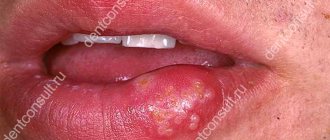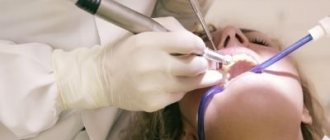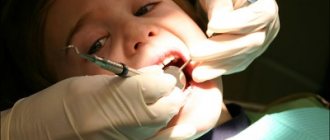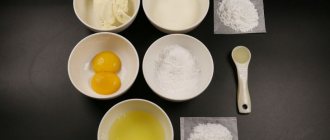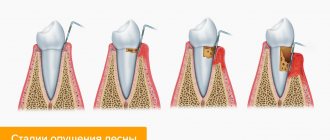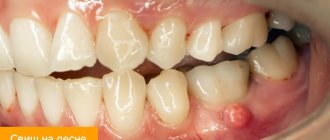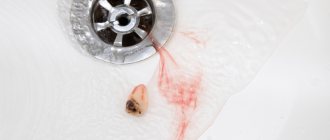White ulcer on the oral mucosa: how to deal with the problem
White sores in the mouth appear quite often. Although the problem cannot be called critical, it causes significant discomfort. Difficulty talking, chewing, swallowing and smiling. In some cases there is pain. Therefore, everyone who has ulcerative formations wants to get rid of them as quickly as possible. In this case, you cannot self-medicate. To determine the cause of the ulcers and prescribe effective therapy, it is necessary to undergo examination by a specialist.
Question No. 1. What causes the problem
Do you have white spots on the mucous membranes of your mouth? You need to understand that this in itself is not a disease. As a rule, this is a sign indicating some kind of pathology.
Injuries
The most common reason why a white spot appears in the mouth is injury to the delicate mucous membrane. Absolutely anyone who prefers irritating foods can get tissue damage: hot, spicy, sour, salty, hard foods. Or, for example, he brushes his teeth aggressively and incorrectly.
A white spot in the mouth is often found by smokers and those who abuse alcohol.
If there is a white spot on your cheek inside your mouth, then you may have recently accidentally bitten your cheek. By the way, this is a very common problem, you can read about it in more detail in the feature article on the site.
Smokers often experience these symptoms
Diseases
Sometimes white spots on the cheek, palate and mucous membranes of the mouth are a sign of the following diseases of the body: measles, candidiasis, herpetic and aphthous stomatitis, leukoplakia, lichen planus, cancer of the gums and oral cavity, syphilis, tonsillitis, pharyngitis, tuberculosis. They may also indicate vitamin deficiency, pathologies of internal organs (liver, kidneys1).
White spots may indicate leukoplakia
Allergy
The sign may indicate an allergic reaction that occurs due to the use of various medications, food, the use of inappropriate cosmetics and personal hygiene.
The white spot may be an allergic reaction
“A white spot somehow formed on the inside of my cheek, which itched terribly. Coincidentally, not long before this I started using a new toothpaste and mouthwash from the same series. I immediately thought it was an allergy. And exactly! As soon as I put these funds aside, everything went away in 3 days. A few months later I decided to try again, and voila, everything came back! But I know my body, because I’m always allergic to something, I always keep antihistamines on hand.”
FoxY, review from the dental portal gidpozubam.ru
Symptoms of ulcerative lesions of the oral mucosa
An oral ulcer is a sign of pathological processes occurring in the body. It looks like a round or oval wound with uneven, soft edges and a loose bottom. The tissues swell. Such lesions can be single or multiple. The localization locations are different: under the tongue or on it (especially at the edges), on the cheek, palate, in the throat, on the inside of the lower or upper lip, on the mucous gingival tissues. Symptoms that may accompany the formation of ulcers:
- itching felt in the affected area;
- bad breath;
- pain when eating;
- increased body temperature;
- increased salivation.
Mouth ulcers can occur in adults and children. When they form, the layer that is responsible for restoring the integrity of the gums is affected. In most cases, the ulcers do not reach large sizes and disappear after 2 weeks. Improvement should be observed within 7 days. If unpleasant symptoms do not go away, or their severity increases, you should consult a doctor.
Symptoms and treatment of leukoplakia -
Leukoplakia is characterized by the fact that under the influence of various irritants, keratinization of the epithelium of the oral mucosa begins to occur. This process occurs due to a violation of the desquamation of the epithelium in those areas of the mucous membrane that is exposed to pathological irritants. These irritants can be:
- smoking,
- sharp edges of carious teeth,
- overhanging edges of fillings,
- malocclusion,
- excessive consumption of spices, very hot foods,
- poorly manufactured removable dentures,
- the presence of artificial crowns made of different metals on the teeth, which gives rise to galvanic currents in the oral cavity.
White spots on the gums with leukoplakia: photo
Symptoms of leukoplakia:
The main element of leukoplakia is a white plaque, which may rise above the level of the mucous membrane, but may not rise (as in Fig. 4). In addition, the plaque can have both clear and blurred boundaries. Patients most often call such plaques white spots. As a rule, white spots do not bother their owners and are discovered completely by accident.
In some cases, patients may be concerned about the roughness of the mucous membrane at the site of the white spot, as well as the fact that the mucosa in this place may rise above the level of the mucosa. In some cases, cracks and ulcers may appear on the surface of the stain; in this case, the patient may also be bothered by burning and pain. If leukoplakia develops as a result of smoking, then, as a rule, patients first of all complain of dryness and burning of the oral mucosa (24stoma.ru).
Treatment of leukoplakia will primarily involve eliminating exposure to the irritating factor. Those. it will be necessary to eliminate the impact of the overhanging edge of a filling or crown, replace old low-quality dentures, normalize oral hygiene, and of course, solve something with the effects of nicotine and hot dry air on the mucous membrane (which occurs when smoking).
Only after this are prescribed keratolytic agents for topical use (3-5-10% salicylic acid, celandine infusion), and vitamin therapy. Applying any treatment procedures without eliminating the causative factor will be useless.
The danger of leukoplakia –
Leukoplakia belongs to the category of precancers. Malignancy of leukoplakia, i.e. its transition to cancer occurs in 15-75% of cases (depending on its form). Therefore, if you do not want to develop cancer of the oral mucosa, you need to urgently go to the dentist and look for the cause of its appearance. But in the photo below you can see photos of two clinical cases when leukoplakia transformed into a malignant tumor of the oral mucosa and the red border of the lips.
Cases of cancer associated with leukoplakia –
Causes of lesions in the mouth
To determine how to treat a pathology, you must first find out why it appeared. In most cases, ulcerative lesions occur against the background of reduced immunity, lack of vitamins and microelements, in particular iron and folic acid. The most common causes of ulcers:
- Different types of stomatitis. The aphthous form of the disease is accompanied by the appearance of white or yellow lesions in the center with a red border. Such wounds are 0.3–1 cm in diameter. Pain during the disease is often moderate, in some cases it is severe. If large wounds form, a careful approach to treatment is needed. With candidal stomatitis, caused by fungi of the genus Candida, the ulcers are covered with a characteristic cheesy coating.
- Injury to the mucous membrane. Various factors can provoke a pathogenic process: mechanical influence (with an incorrectly installed filling, caries, improper fitting of dentures, etc.) or thermal (eating hot food), chemical (smoking, exposure to caustic drugs). Even a simple bite of the cheek or tongue injures the tissue. In a child who frequently sucks his thumb, ulceration may occur on the soft palate. The habit of biting nails and pencils also provokes the formation of microtraumas. When they get infected, inflammation develops.
- General diseases of a systemic or chronic nature (disorders of the gastrointestinal tract, tuberculosis, syphilis and HIV, blood diseases). In rare cases, the cause of their formation is oral cancer. Viral diseases also provoke ulcers. Sore throat and tonsillitis can cause lesions on the tonsils.
White sores on the oral mucosa are sometimes a consequence of taking certain medications. They are also formed when there is insufficient saliva production. The problem can be provoked by the use of toothpastes containing sodium lauryl sulfate and triclosan.
Prevention
To avoid purulent and ulcerative formations on the oral mucosa, it is recommended to visit the dentist in a timely manner, follow basic rules for caring for teeth and gums at home, and avoid excessively hot and cold drinks (food). Strengthening the immune system, a healthy diet and regular physical activity, coupled with psycho-emotional stability, will also help prevent the occurrence of this problem.
So, the appearance of various formations on the oral mucosa can be caused not only by infectious and inflammatory dental diseases, but also by problems within the body. The main “culprit” of white sores in the mouth is considered to be stomatitis, which “attacks” the mucous membrane with reduced immunity. Vitamin deficiency, syphilis, tuberculosis, cancer are systemic pathological causes of rashes. Treatment depends on why the ulcerated areas or ulcers appeared. The dentist should select medications and procedures.
What to do if a white sore appears in your mouth
If ulcerations are detected, you should contact your dentist, especially if they do not heal on their own. The doctor will tell you how to treat the wounds, comparing the problem with the causative factor. The following drugs are most often prescribed:
- Antiseptic solutions for rinsing: “Chlorhexidine” 0.05%, “Miramistin” 0.01%, “Furacilin” (a prepared preparation that does not require dilution). It is important to take into account the concentration of the active substance so as not to get a burn to the oral cavity.
- Anti-inflammatory drugs. To eliminate white ulcers in the mouth, alcohol tinctures from medicinal plants are used. For example, “Chlorophyllipt”, “Stomatophyte”. If a white sore appears in a child, gels (Metrogil Denta, Cholisal) are prescribed, which also have an analgesic effect.
- Antibacterial agents. Prescribed if ulcers are caused by bacteria (tuberculosis bacillus, streptococci, etc.).
- Antifungal agents. Fluconazole and Ketoconazole effectively combat fungi.
Any medications can be taken only as prescribed by a doctor. Self-medication can cause complications! To speed up the action of drugs, electrophoresis, phonophoresis or laser treatment methods are prescribed.
In addition to the complex of drug therapy, you can rinse using decoctions based on medicinal herbs (chamomile, oak bark, sage, calendula). Sometimes a course of vitamins and immunostimulating drugs is also prescribed, especially if the ulcers are chronic.
How to avoid candidiasis?
To prevent the disease, you must follow a few simple rules:
- maintain oral hygiene;
- consult a dentist at least twice a year, even if there are no complaints;
- control nutrition, avoid excess carbohydrates in food;
- refrain from smoking, which can cause a chronic form of the disease.
Treatment of candidiasis of the oral mucosa can take a long time and also cause irreparable harm to health, so we recommend that you take care of yourself in advance by following preventive measures. If symptoms have already begun to appear, consult a doctor as soon as possible so that the infection does not have time to spread to other organs. You can undergo oral cavity diagnostics at Comfort Dentistry. Our specialists will tell you in detail about the prevention of common diseases of teeth and gums, and also, if necessary, provide high-quality treatment.
Special recommendations for the treatment of white ulcers on the oral mucosa
To quickly get rid of unpleasant ulcerations in the mouth, you need to follow a diet. Your diet should include vegetables, fruits, red meat, and fish. It is important to avoid spicy and sour foods, such as citrus fruits, until complete recovery. Any rough food (nuts, etc.) that can injure the mucous membrane is also excluded. Sweets (cakes, jam, chocolate), crackers, chips, coffee are also prohibited.
It is important to pay attention to the quality of the water consumed. The heavy metal salts and other impurities it contains can cause constant bleeding from the gums and contribute to infection. If the pathology is provoked by some disease, it is necessary to eliminate it.
Treatment
The treatment program is selected depending on what causes the white plaque on the gums:
- Antifungal drugs. Prescribed if the disease is caused by candida.
- Treatment of the oral cavity with antiseptics. To do this, you can use hydrogen peroxide, chlorhexidine, miramistin, and potassium permanganate solution. Apply the product to a sponge and gently apply it to the affected areas.
- Special toothpastes. The doctor will recommend the use of special pastes that contain the enzymes lactoferrin, lactoperoxidase, and lysozyme. They are necessary in order to restore the microflora.
- Therapy aimed at restoring the immune system. The specialist will recommend medications, vitamins, and a special diet.
